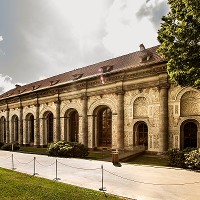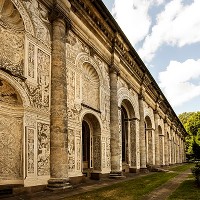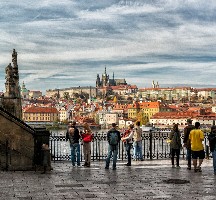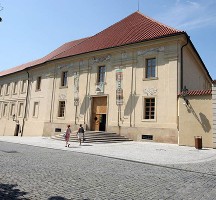Breadcrumbs navigation
Prague Castle – Ball Games Hall (Míčovna)
This Renaissance building on the south side of the Royal Gardens, directly above the Stag Moat, was built from 1567 to 1569. It served as a ball games hall, and later as a riding school and stables. During the reign of Josef II it was used as a military storage facility. Today it serves primarily for art exhibitions, concerts and significant social events.
- Monuments & Architecture
- house
- castle/chateau
- Renaissance
Contacts
- Prague Castle – Ball Games Hall (Míčovna)
- Pražský hrad
- 119 08 Praha 1 – Hradčany
- +420224372435
- +420224372419
Object history
Architects Bonifác Wohlmuth and Oldřich Aostalis built it in the years 1567 - 1569 on the edge of the lower part of the Deer Moat (Jelení příkop). The building on a ground plan of 68 times 13 metres was a true gem of high-Renaissance architecture. Among ten Ionian half-pillars, there were sgraffitoes reaching as high as 14 m - personification of four elements (Earth, Air, Fire, Water), seven main virtues (Forethought, Restraint, Mercy, Hope, Justice, Bravery, Faithfulness), and eight free arts (Theology, Astronomy, Geometry, Music, Arithmetics, Rhetorics, Dialectics, Grammar). In the 1950s an emblem of a Five-Year Plan with a sickle and a hammer were added in the third arch on the left as an allegory of industry and agriculture. (Curiously the only preserved feature of social realism within the Prague Castle premises).
At the time of its construction, the Ball game hall was the third building within Prague Castle designed for ball games, which were very popular back then. Round ball games were played with 10 - 12 players, and the ball was rebound by a wooden bat or a loose shoe, or a hard leather ball was cast at an opponent, who was supposed to catch it airborne.
In 1723, the Ball game hall was converted into a stable; during the reign of Joseph II it was changed into an army storage house. On the 9th May 1945 it was hit by shooting and burnt down completely; only the peripheral walls were preserved. After the war it was rebuilt by Pavel Janák, the originally open arches were now glazed in. Sgraffitoes were restored in 1952 by the sculptor Josef Wagner, who only prolonged their durability, and again in the years 1971 - 1973 by an association named Štuko. This time, a demanding and difficult restoring approach was selected, first to fix the plaster, which crumbled away on a mere touch, and then academic sculptors Miroslav Kolář and Dušan Křička worked for two years on the actual restoration of the sgraffitoes.
The sculpture named Night from 1734 by Matyáš Bernard Braun, situated in front of the Ball game hall, used to have its opposite named Day, which was destroyed in Prussian siege in 1757. The area in front of the Ball game hall is dominated by the Hercules’ Fountain. In the Baroque niche designed by architect Francesco Carratti, there is a statue of Hercules fighting a dragon by Jan Jiří Bendl dating back to 1670.
The Ball game hall is used for concerts, exhibitions and social events today.
Prague Castle has been a National Cultural Monuments since 1962.
Information source: www.hrad.cz







